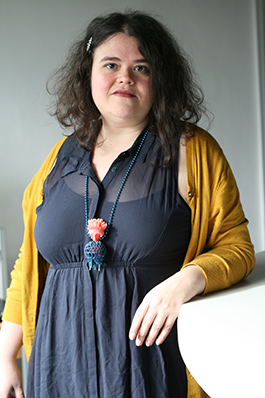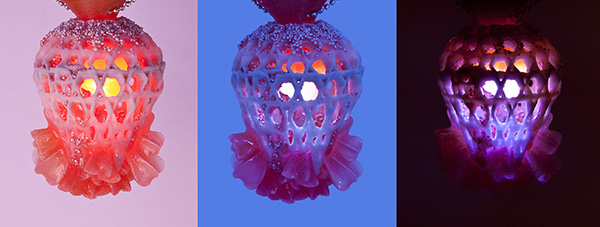An Edinburgh Napier academic is putting the fun back into fashion by designing her own range of interactive jewellery.
Katharina Vones has produced a range of pendants that alter in colour and appearance in response to certain changes in light, temperature and movement.
The researcher, who has just completed her PhD studies in the use of smart materials for Interactive Craft, has developed her HyperHive series of pendants with a view to producing playful pieces that will appeal to both children and adults.
Taking inspiration from microcosmic images of natural items such as shells and moss, the casings for the pendants have been 3D-printed in biodegradable PLA, and are embellished with thermochromic silicone shapes that change colour in relation to temperature.
The range itself – which includes the HyperLight, the HyperTilt and the HyperTouch Pendants – incorporates technology such as light, touch and movement sensors that help the jewellery come alive when worn.
The three pieces react automatically in different environments – with changes in light, movement and even from hot temperatures to colder temperatures triggering the pendants to morph into a different colour.
The result of her work is a unique and innovative take on jewellery design that is a step change away from the more traditional use of materials such as gold, silver and copper.
With her studies now complete, Katharina hopes to bring the pieces to a commercial market, along with giving individuals the ability to harness her technology to potentially build their own.
She said: “My love for jewellery design stems from my time studying in Edinburgh and I’ve been using silicone in my designs since 2006. I have done work in the past with more traditional materials but I’ve always been fascinated with 3D design and the idea of adding a sense of playfulness to jewellery and the way it can be designed.

“My recent PhD at Edinburgh Napier looked at using smart materials such as silicone in interactive craft and it was during this time that my HyperHive series was born. There are three main pieces, each of which react to the body and environment in different ways. Touch, light and movement are all important factors in determining how the pendants will appear – there really is a sense of magic when the pieces being to automatically change.
“The aim is to bring this type of jewellery to a commercial market and to eventually allow both children and adults to build their own using the technology that I’ve harnessed through my own work. Jewellery and fashion is often chastised for taking itself a bit too seriously so by being innovative and different, I’m hoping to change that.”
Katharina’s HyperHive series will be one of a number of works on display at the Research Through Design conference at Edinburgh’s National Museum of Scotland between 22-24 March.
Hosted by Edinburgh Napier University and University of Edinburgh (Royal College of Art), RTD 2017 will bring together a number of the UK’s leading design academics who will share their research and work in a unique curated exhibition. A range of key note speeches, design workshops and panel discussions are also part of its line-up.
For more information and to view the full programme for RTD 2017, please visit
here.